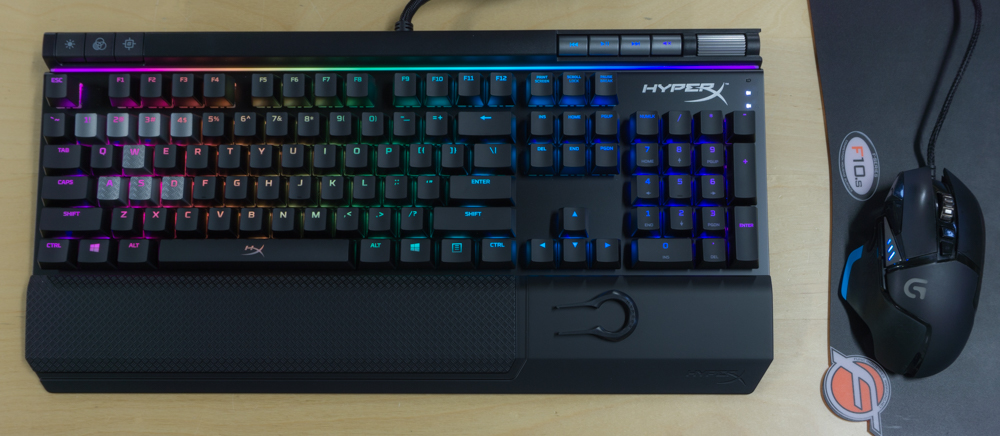Tom's Hardware Verdict
If you need a light bar on your mechanical gaming keyboard but don’t want or need extra macro keys, the HyperX Alloy Elite RGB is a high-quality option. But competing options feel more polished overall.
Pros
- +
Excellent build quality
- +
Light bar colors blend well
- +
Standard bottom row allows keycap replacement
Cons
- -
Aging USB 2.0 passthrough port
- -
Software UI can be clunky
- -
Keycaps will show finger grease and shine quickly
Why you can trust Tom's Hardware
Features & Specifications
HyperX, a subsidiary of desktop memory giant Kingston, is actively following the path into the peripherals market that was paved by the company's well-received line of headsets--the HyperX Cloud Alpha is our current pick for best wired gaming headset. The Alloy Elite RGB keyboard (which appears to have gone by the codename “DartFrog” internally at the company) is the company's fourth keyboard and current flagship, designed to compete with the likes of Corsair and Razer in the high-end gaming keyboard market. Models like the K70 LUX RGB and Blackwidow Chroma V2 are set squarely in the Alloy Elite RGB’s sights.
A $170 price tag actually puts Elite RGB in a slightly higher price tier than the K70 RGB or Chroma, but its full-size 104-key layout doesn’t compete with keyboards like the K95 RGB Platinum (which has an extra bank of macro keys). The Elite RGB offers mostly the same features as its competitors, with one exception: its RGB light bar, which adds color to a bezel area that is bare in most mechanical keyboards. (Even that appears on some other higher-end boards these days, though.) There are also dedicated media buttons, game mode/lighting mode control buttons, a few Cherry switch options, and a much-appreciated metal volume roller.
You also get a spate of features that are present on most higher-end gaming keyboards, including Windows key lock modes, macros, and per-key RGB programmability. Macros are often useful in solo games and design software, but it surprises us that so many brands lean on them as a feature meant for competitive online gamers. In most ranked or scored titles, macros are banned (or at least frowned upon).
The only feature that feels out of place here is the USB 2.0 passthrough port. It’s an improvement over the Alloy FPS, which could only charge devices via USB, but an upgrade to USB 3.0 would be ideal. USB 2.0’s 500 mA maximum current isn’t optimal for charging phones and other high-demand devices. USB 3.0, on the other hand, offers 900+ mA of current.
Specifications
| Switch | Cherry MX RGB Brown |
| Lighting | RGB |
| Onboard Storage | ✓ |
| Media Keys | ✓ |
| Game Mode | ✓ |
| Microcontroller | NXP LPC11U35F |
| Key Rollover | NKRO |
| Polling Rate | 1,000 Hz |
| Interface | (2) USB 2.0 |
| Cable | 2 m (~6.5 ft.), Braided |
| Additional Ports | USB 2.0 passthrough |
| Keycaps | Painted ABS, translucent legends |
| Construction | Plastic case, metal plate |
| Accessories | Soft-touch wrist rest, novelty WASD keycaps |
| Software | HyperX NGenuity |
| Dimensions (W x D x H) | 44.5 x 17 x 3.7 cm (17.5 x 6.7 x 1.45 in.) |
| Weight | 1.46 kg (3.2 lb.) |
| Warranty | Two-year limited |
MORE: How We Test Mechanical Keyboards
MORE: Mechanical Keyboard Switch Testing Explained
MORE: All Keyboard Content
Get Tom's Hardware's best news and in-depth reviews, straight to your inbox.
-
AgentLozen You had some positive things to say about this keyboard in the conclusion. Would it appear on your short list of recommendations or do you think buyers should look elsewhere?Reply
On the topic of the conclusion, I like that it makes an appearance on the front page now. I know Tomshardware made that change a little while ago, but I'm more willing to look at an article if know I can read the conclusion right away. Otherwise I usually just skip over topics like keyboards.
